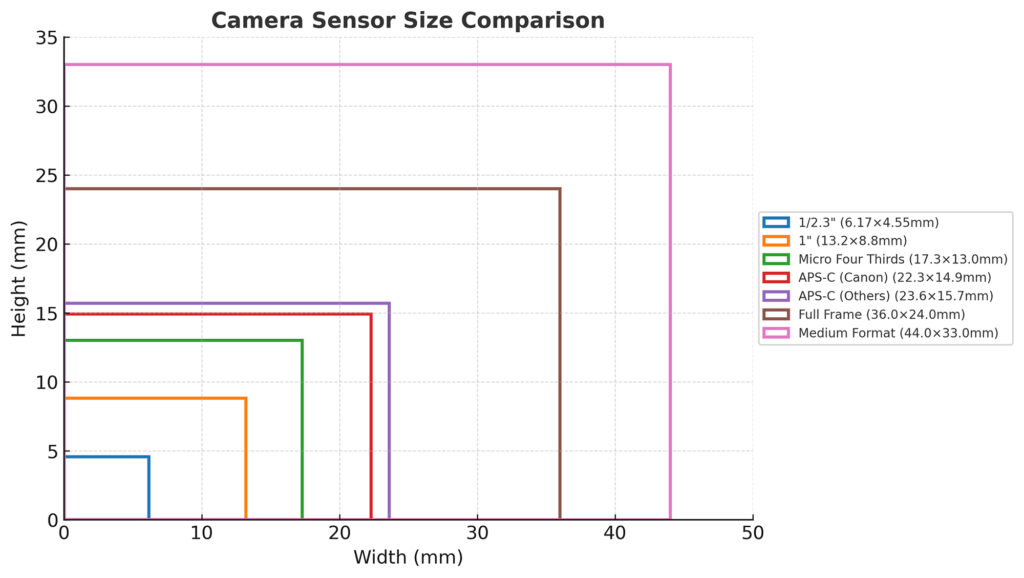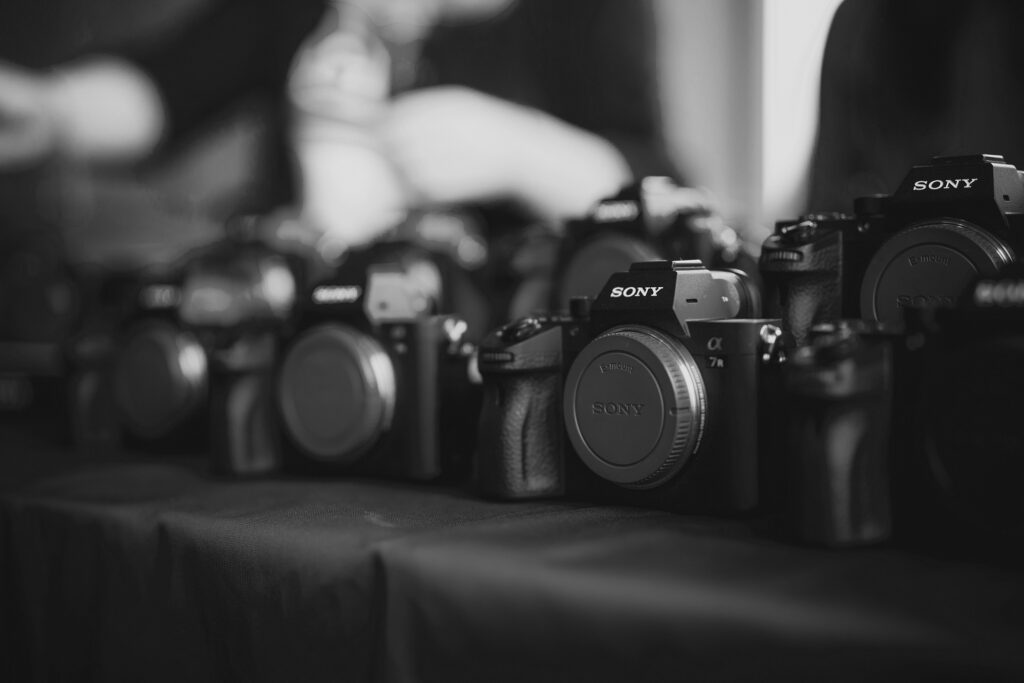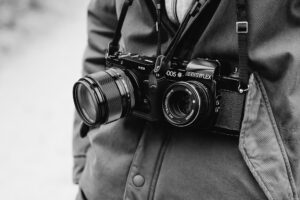Choosing your first camera can feel overwhelming with so many terms and types being thrown around: mirrorless, DSLR, crop sensor, full-frame, and more. But once you understand the core differences between camera types and sensor sizes, narrowing down your options becomes a lot easier. In this guide, we’ll break down the most common categories of digital cameras, explain what sensor size really means for image quality, and help you decide what to prioritize depending on your goals.
TL;DR
- Camera sensor size affects image quality, depth of field, and low-light performance. Larger sensors (like full-frame) generally offer better results.
- Common sensor sizes include Full-Frame, APS-C (crop), and Micro Four Thirds. Each has its own advantages for different needs and budgets.
- Camera types include compact (point-and-shoot), DSLR, mirrorless, action, cinema, and medium format cameras.
- DSLRs are reliable and have great lens ecosystems, but mirrorless cameras are more compact and offer faster performance.
- Resolution (megapixels) matters, but not as much as sensor size and lens quality for overall image quality.
- Consider what you shoot and how you work when choosing a camera — there’s no one-size-fits-all.
This post is just one part of my “Camera Buying Guide“, which you can download as a pdf file right now.
What Is a Camera Sensor and Why It Matters
Back in the film era, photographs were captured on rolls of film that had to be developed in a darkroom. In digital cameras, film has been replaced by a sensor: a light-sensitive chip that captures your images.
The sensor is the most critical (and expensive) part of a digital camera. The larger the sensor, the more light it can capture, resulting in better image quality, especially in low light conditions. A bigger sensor also usually means bigger pixels and less noise.
Camera Sensor Sizes Compared
Here are the common sensor sizes, from smallest to largest:
- 1/2.3″ (used in many compact and action cameras)
- 1/1.7″
- 1″
- Four Thirds (Micro Four Thirds)
- APS-C – also called crop sensor
- Full Frame – equivalent to 35mm film, considered the standard in photography
- Medium Format – larger than full frame, used in high-end commercial work
Sensor size affects depth of field, dynamic range, and overall image quality: a key concept in any camera buying guide.
Sensor size also ties directly into resolution and other camera specifications.

Megapixels and Sensor Resolution
Megapixels refer to how many million pixels a camera uses to create an image. While higher megapixel counts give you more detail and flexibility to crop or print large, it’s not the only factor in image quality.
Here’s what you need to know:
- 8-12 megapixels is out of date but probably still enough for web use or small prints.
- 20+ megapixels gives you more room for editing and cropping.
- 40+ megapixels may be overkill unless you’re doing large-scale printing or high-end commercial work.
But there’s more to the story than pixel count.
- Pixel size matters: Larger sensors with fewer megapixels have larger individual pixels, which capture more light and generally produce better images, especially in low light.
- DPI (dots per inch) matters mainly for print, not screen. So if you’re sharing online, don’t stress about DPI.
While it’s tempting to chase higher megapixels, remember that even budget-friendly cameras today offer more resolution than most people will ever need. That said, if you’re a landscape photographer planning to sell large prints, look for cameras in the 30-50MP range.
Types of Digital Cameras: What Are Your Options?
Let’s look at the main categories of digital cameras on the market today and see which one might be right for you.
Compact Cameras (Point-and-Shoot): Pros and Cons
Compact cameras are lightweight, portable, and easy to use. You don’t change lenses on these, they come with a built-in zoom lens. Some are fully automatic, while others offer manual controls and RAW shooting.
Today’s advanced compact cameras offer surprisingly good image quality, often using 1-inch sensors, and are great for casual photography, travel, or social media use. Some even shoot in 4K and have flip screens for vlogging.
There’s also a subtype called bridge cameras, which look like DSLRs but don’t have interchangeable lenses. They usually have massive zoom ranges and more manual controls.
Best for: Beginners, travelers, vloggers, or anyone who values convenience over customization.
DSLR Cameras: What Makes Them Popular
Once the gold standard for enthusiasts and professionals, DSLRs (Digital Single-Lens Reflex cameras) use a mirror system to direct light from the lens into an optical viewfinder. When you press the shutter button, the mirror flips up and the light hits the sensor.
There are two main types of DSLRs:
- Full-frame DSLRs have a sensor size equivalent to 35mm film. These are great for professionals and serious hobbyists who need the best quality.
- APS-C (Crop-frame) DSLRs have smaller sensors but are more affordable and lighter. They’re ideal for beginners who want room to grow.
All DSLRs support interchangeable lenses, RAW shooting, and manual controls.
However, DSLRs are becoming less common as mirrorless cameras take over the market. But that also means that they’re usually cheaper to buy for beginners who don’t want to spend a lot.
Best for: Beginners on a budget (crop sensor), professionals with existing gear, or those who prefer optical viewfinders.
Mirrorless Cameras: Lighter, Faster, and the Future?
Mirrorless cameras are now the dominant force in photography and video. They have no mirror, which means they’re lighter and more compact than DSLRs. Instead of an optical viewfinder, they use electronic viewfinders (EVFs) or just the rear LCD.
Thanks to technological advancements, mirrorless cameras now offer better autofocus, faster burst shooting, and excellent video capabilities, often outperforming DSLRs in nearly every category.
They come in both APS-C and Full Frame versions, and all support interchangeable lenses, RAW formats, and professional-level customization.
Recent mirrorless models from different brands are widely regarded as the best photography cameras and also double as some of the best videography cameras available.
Best for: Almost everyone, from beginners to pros, photographers to videographers.
Action Cameras: Built for Adventure
Action cameras have improved dramatically over the past few years. Once limited to niche sports and casual vlogging, today’s action cams offer high-resolution video (even higher than 4k in some cases), excellent stabilization, and RAW photo capabilities in incredibly small and durable bodies.
Modern models feature better low-light performance, waterproofing, horizon leveling, and seamless wireless workflows.
While they still have smaller sensors and wide-angle lenses that can cause distortion, the results can be impressive, especially for travel, sports, and social content.
Best for: Adventure seekers, travel vloggers, social media creators, and anyone focused on video creation who wants a pocket-sized camera always ready to go.
Cinema Cameras: For Professional Video Shooters
If you’re serious about filmmaking, especially for commercial or narrative video production, you might eventually graduate to a cinema camera.
These are built for video-first workflows, with high bitrates, 10-bit or 12-bit color, internal ND filters, professional audio inputs, and advanced dynamic range.
While they aren’t ideal for casual use due to their size and complexity, cinema cameras are perfect for projects where visual quality and color grading flexibility matter most.
Best for: Professional filmmakers, video production companies, and high-end content creators.
Medium Format Cameras: High-End Image Quality
Medium format cameras have sensors even larger than full frame, offering exceptional resolution, detail, and dynamic range. They’re used primarily in commercial, fashion, and fine art photography where every pixel matters.
These cameras are expensive and slower to use, but the results -especially for large prints or billboards- are unmatched.
Best for: Studio photographers, high-end advertising, and large-format printing.
If you’re weighing these options for your next purchase, our how to choose a camera post can help you narrow it down.
Reminder: This post is just one part of my “Camera Buying Guide“, which you can download as a pdf file right now.
Last Words
There’s no single best camera for everyone. What matters most is finding the right tool for the way you shoot. Whether you’re drawn to the classic feel of a DSLR, the compact power of a mirrorless camera, or just want something simple for everyday snapshots, understanding camera types and sensor sizes will help you make a smart investment. Keep your needs in focus, and let the technical specs serve your creativity, not the other way around.
FAQ
How does sensor size affect image quality?
Larger sensors (like full-frame) capture more light, provide better low-light performance, and offer smoother background blur.
Which camera type is best for hybrid shooters (photo + video)?
Mirrorless cameras -especially full-frame mirrorless- offer compact size, modern features, and strong video capabilities.
Are action or cinema cameras worth considering?
Yes, if you’re shooting adventures or cinematic video, each brings specific advantages like ruggedness or high bitrate recording.




